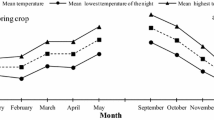Abstract
Experiments performed in 1976 and 1977 examined the effect of harvest date on the development of tuber-borne sclerotia and the effect of these sclerotia onRhizoctonia disease severity of potato. Results from tubers harvested at seven weekly intervals in 1975 indicate maximum sclerotial development occurred 3–4 weeks after vine killing. When these tubers were planted the following year, few differences occurred in disease severity of stems and stolons with respect to prior harvest date. However, the tubers which had remained in the ground 4–7 weeks after vine killing in 1975 produced the largest and greatest number of sclerotia on progeny tubers harvested in 1976. Experiments in 1976 and 1977 demonstrated that tubers with approximately 20% sclerotial coverage produced stems and stolons with significantly more severeRhizoctonia disease compared to tubers with no visible sclerotia. Sclerotial coverage on tubers of less than 20% did not significantly increase disease severity.
Resumen
Experimentos realizados en 1976 y 1977 analizaron los efectos de fecha de cosecha en el desarrollo de esclerotes en los tubérculos y el efecto de estos esclerotes en la severidad del ataquede Rhizoctonia en papas. Resultados de tubérculos cosechados semanalmente por siete semanas en 1975 indican que el máximo desarrollo de esclerotes ocurrió 3–4 semanas luego que el follaje fue muerto. Cuando estos tubérculos fueron plantados al año siguiente pocas diferencias ocurrieron en severidad de la en fermedad en tallos y estolones con respecto a tubérculos cosechados en fechas anteriores. Sin embargo, los tubérculos que permanecieron en el campo 4–7 semanas luego que el follaje fue muerto, en 1975, produjeron más número y esclerotes más grandes en los tubérculos progenies cosechados en 1976. Experimentos en 1976 y 19877 demostraron que tubérculos con aproximadamente 20% de esclerotes cubriendo la superficie produjeron tallos y estolones significativamente más afectados porRhizoctonia comparado con tubérculos sin esclerotes visibles. Esclerotes en cantidad menor de 20% cubriendo la superficie de los tubérculos no aumentaron significativamente la severidad de la enfermedad.
Similar content being viewed by others
Literature Cited
Banville, G.J. 1978. Studies on theRhizoctonia disease of potatoes. Am Potato J 55:56.
Barker, K.R. and J.C. Walker. 1962. Relationship of pectolytic and cellulytic enzyme production by strains ofPellicularia filamentosa to their pathogenicity. Phytopathology 52:1119–1125.
Davis, J.R. 1978. TheRhizoctonia disease of potato in Idaho. Am Potato J 55:58–59.
Embden, J.H., van. 1965.Rhizoctonia solani: results of experiments. Eur Potato J 8:188–189.
Frank, J.A. 1975. The relative importance of potato tuber-borneRhizoctonia in comparison to soil-borne inoculum. Am Potato J 52(8):244. (Abstr.).
Frank, J.F. 1978. TheRhizoctonia disease of potatoes in Maine. Am Potato J 55:59.
Hirst, J.M., G.A. Hide, R.L. Griffith and O.J. Stedman. 1970. Improving the health of seed potatoes. J R Agric Soc Engl 131:87–106.
James, W.C. and A.R. McKenzie. 1972. The effect of tuber-borne sclerotia ofRhizoctonia solani Kuehn on the potato crop. Am Potato J 49(8):296–301.
Leach, L.D. and R.H. Garber. 1970. Control ofRhizoctonia. p. 189–198in Biology and Pathology ofRhizoctonia solani. J.R. Parameter, Jr. (ed.). Univ. Calif. Press, Berkeley, 255 pp.
LeClerg, E.L. 1941. Comparative studies of sugar beet and potato isolates ofRhizoctonia solani. Phytopathology 31:274–278.
McKinney, H.H. 1923. Influence of soil temperature and moisture on infection of wheat seedlings byHelminthosporium sativum. J Agric. Res 26(5): 195–218.
Papavizas. G.C. 1970. Colonization and growthof Rhizoctonia solani in soil. p. 108–122in Rhizoctonia solani: Biology and Pathology ofRhizoctonia solani. J.R. Parameter, Jr. (ed). Univ. Calif. Press, Berkeley, 255 pp.
Person, I.H. 1945. Pathogenicity of isolates ofRhizoctonia solani from potatoes. Phytopathology 35:132–134.
Small, T. 1943. Black scurf and stem canker of potato (Corticium solani Bourd & Galz.). Field studies of the use of clean and contaminated seed potatoes and on the contamination of crop tubers. Ann Appl Biol 30:221–226.
Small, T. 1945. Black scurf and stem canker of potato (Corticium solani Bourd. & Galz.). Further field studies on the use of clean and contaminated seed potatoes and on the contamination of crop tubers. Ann Appl Biol 32:206–209.
Weinhold, A.R., T. Bowman and D.H. Hall. 1978. Rhizoctonia disease of potato in California 55:56–57.
Author information
Authors and Affiliations
Additional information
Paper No. 883, North Dakota Agricultural Experiment Station.
Late Professor.
Rights and permissions
About this article
Cite this article
Gudmestad, N.C., Zink, R.T. & Huguelet, J.E. The effect of harvest date and tuber-borne sclerotia on the severity ofRhizoctonia disease of potato. American Potato Journal 56, 35–41 (1979). https://doi.org/10.1007/BF02851121
Received:
Issue Date:
DOI: https://doi.org/10.1007/BF02851121




